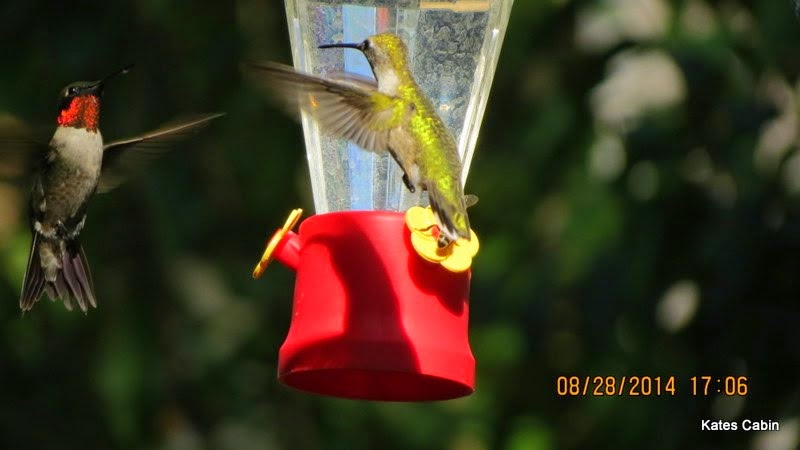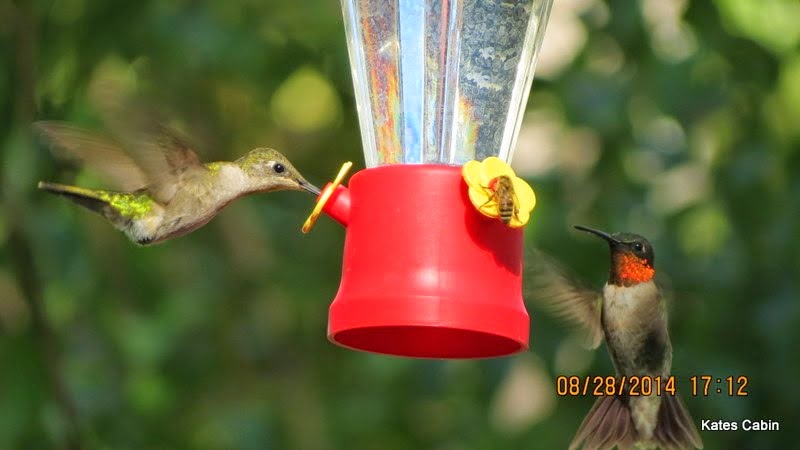
Hi Everybody!!
I wonder if there are people out there who do not know what a bird is? Shared below is the Wikipedia definition of Bird. August 28 (part b) was a sunny afternoon in the bird feeding arena. Sometimes in the right angle of light, the hummingbirds wings light up in the camera. This is a short window of about 15 minutes to catch this effect. Other times when the sun is shining on the birds, the green feathers can appear golden. These little guys are so fast and I am lucky to catch them at all! One thing I know to be true: I can only photograph the birds when they are here (6 weeks-2 months). I tried to catch all the different birds so you could see them. Enjoy!

Link to Photo Album A:
https://plus.google.com/u/0/photos/117645114459863049265/albums/6065062958466901361








link to Photo Album:
https://plus.google.com/u/0/photos/117645114459863049265/albums/6065064930522678753















https://en.wikipedia.org/wiki/Bird
Bird
From Wikipedia, the free encyclopedia
Birds (class Aves or clade Avialae) are feathered, winged, two-legged, warm-blooded, egg-laying vertebrates. Aves ranks as the tetrapod class with the most living species, approximately ten thousand. Extant birds belong to the subclass Neornithes, living worldwide and ranging in size from the 5 cm (2 in)bee hummingbird to the 2.75 m (9 ft) ostrich. The fossil record indicates that birds emerged within the theropod dinosaurs during the Jurassic period, around 150 million years ago. On 31 July 2014, scientists reported details of the evolution of birds from theropod dinosaurs.[3][4] Most researchers agree that modern-day birds are the only living members of the Dinosauria clade.
Modern birds are characterised by feathers, a beak with no teeth, the laying of hard-shelled eggs, a high metabolic rate, a four-chambered heart, and a lightweight but strong skeleton. Extant birds have more or less developed wings; the most recent species without wings was the moa, which is generally considered to have become extinct in the 16th century. Wings are evolved forelimbs, and most bird species can fly. Flightless birds include ratites,penguins, and diverse endemic island species. Some species of birds, particularly penguins and members of the Anatidae family, are adapted to swim. Birds also have digestive and respiratory systems that are uniquely adapted for flight. Some birds, especially corvids and parrots, are among the most intelligent animal species; several bird species make and use tools, and many social species culturally transmit knowledge across generations.
Many species annually migrate great distances, and many more perform shorter irregular movements. Birds are social, communicating with visual signals, calls, and songs, and participating in such social behaviours as cooperative breeding and hunting, flocking, and mobbing of predators. The vast majority of bird species are socially monogamous, usually for one breeding season at a time, sometimes for years, but rarely for life. Other species havepolygynous ("many females") or, rarely, polyandrous ("many males") breeding systems. Eggs are usually laid in a nest and incubated by the parents. Most birds have an extended period of parental care after hatching.
Many species are economically important, mostly as game or poultry. Some species, particularly songbirds and parrots, are popular as pets. Another use of birds is harvesting guano (droppings) for use as a fertiliser. Birds prominently figure throughout human culture. About 120–130 species have becomeextinct due to human activity since the 17th century, and hundreds more before then. Human activity threatens about 1,200 bird species with extinction, though efforts are underway to protect them.
| Birds Temporal range: Late Jurassic–Holocene,[1] 160–0Ma | |
|---|---|
 | |
| Examples of various avian orders.
Row 1: Red-crested turaco, shoebill, white-tailed tropicbird
Row 2: Steller's sea eagle, black crowned crane, common peafowl Row 3: Mandarin duck, Anna's hummingbird,Atlantic puffin Row 4: southern cassowary, rainbow lorikeet,American flamingo Row 5: gentoo penguin, great blue heron, blue-footed booby Row 6: bar-throated minla, Eurasian eagle-owl,keel-billed toucan | |
| Scientific classification | |
| Kingdom: | Animalia |
| Phylum: | Chordata |
| Superclass: | Tetrapoda |
| Clade: | Eumaniraptora |
| Clade: | Avialae Gauthier, 1986 |
| Class: | Aves Linnaeus, 1758[2] |
Evolution and classification
Main article: Evolution of birds
The first classification of birds was developed by Francis Willughby and John Ray in their 1676 volume Ornithologiae.[5] Carolus Linnaeus modified that work in 1758 to devise the taxonomic classification system currently in use.[6] Birds are categorised as the biological class Aves in Linnaean taxonomy.Phylogenetic taxonomy places Aves in the dinosaur clade Theropoda.[7]
Definition
Aves and a sister group, the clade Crocodilia, contain the only living representatives of the reptile clade Archosauria. During the late 1990s, Aves was most commonly defined phylogenetically as all descendants of the most recent common ancestor of modern birds and Archaeopteryx lithographica.[8]However, an earlier definition proposed by Jacques Gauthier gained wide currency in the 21st century, and is used by many scientists including adherents of the Phylocode system. Gauthier defined Aves to include only the modern bird groups, the crown group. This was done by excluding most groups known only from fossils, and assigning them, instead, to the Avialae,[9] in part to avoid the uncertainties about the placement of Archaeopteryx in relation to animals traditionally thought of as theropod dinosaurs.
Gauthier[10] identified four conflicting ways of defining the term "Aves", which is a problem because the same biological name is being used four different ways. Gauthier proposed a solution, number 4 below, which is to reserve the term Aves only for the crown group, the last common ancestor of all living birds and all of its descendants. He assigned other names to the other groups.
| ||||||||||||||||||
| The birds' phylogenetic relationships to major living reptile groups. |
- Aves can mean those advanced archosaurs with feathers (alternately Avifilopluma)
- Aves can mean those that fly (alternately Avialae)
- Aves can mean all reptiles closer to birds than to crocodiles (alternately Avemetatarsalia [=Panaves])
- Aves can mean the last common ancestor of all the currently living birds and all of its descendants (a "crown group"). (alternately Neornithes)
Under the fourth definition Archaeopteryx is an avialan, and not a member of Aves. Gauthier's proposals have been adopted by many researchers in the field of paleontology and bird evolution, though the exact definitions applied have been inconsistent. Avialae, initially proposed to replace the traditional fossil content of Aves, is often used synonymously with the vernacular term "bird" by these researchers.[1]
Most researchers define Avialae as branch-based clade, though definitions vary. Many authors have used a definition similar to "all theropods closer to birds than to Deinonychus."[11][12] Avialae is also occasionally defined as an apomorphy-based clade (that is, one based on physical characteristics). Jacques Gauthier, who named Avialae in 1986, re-defined it in 2001 as all dinosaurs that possessed feathered wings used in flapping flight, and the birds that descended from them.[10][13]





...this is brendasue signing off from Rainbow Creek. See you next time!

O+O


No comments:
Post a Comment